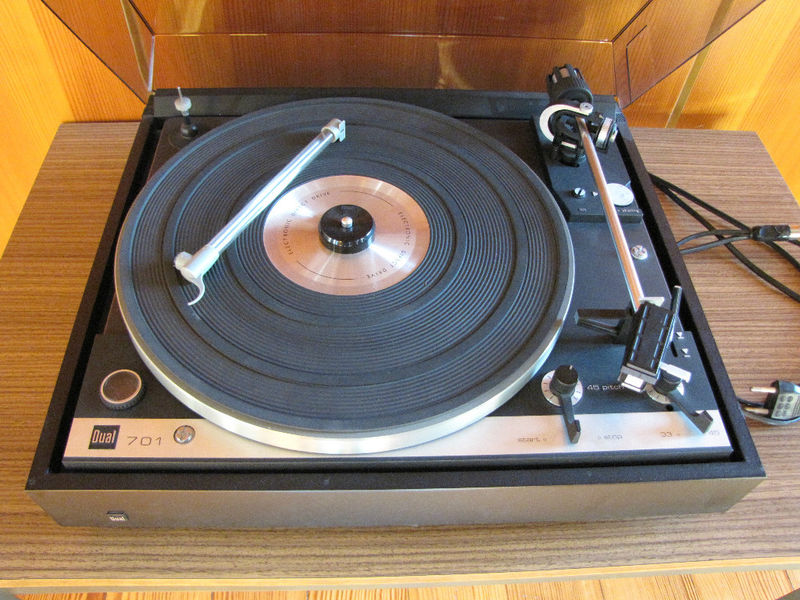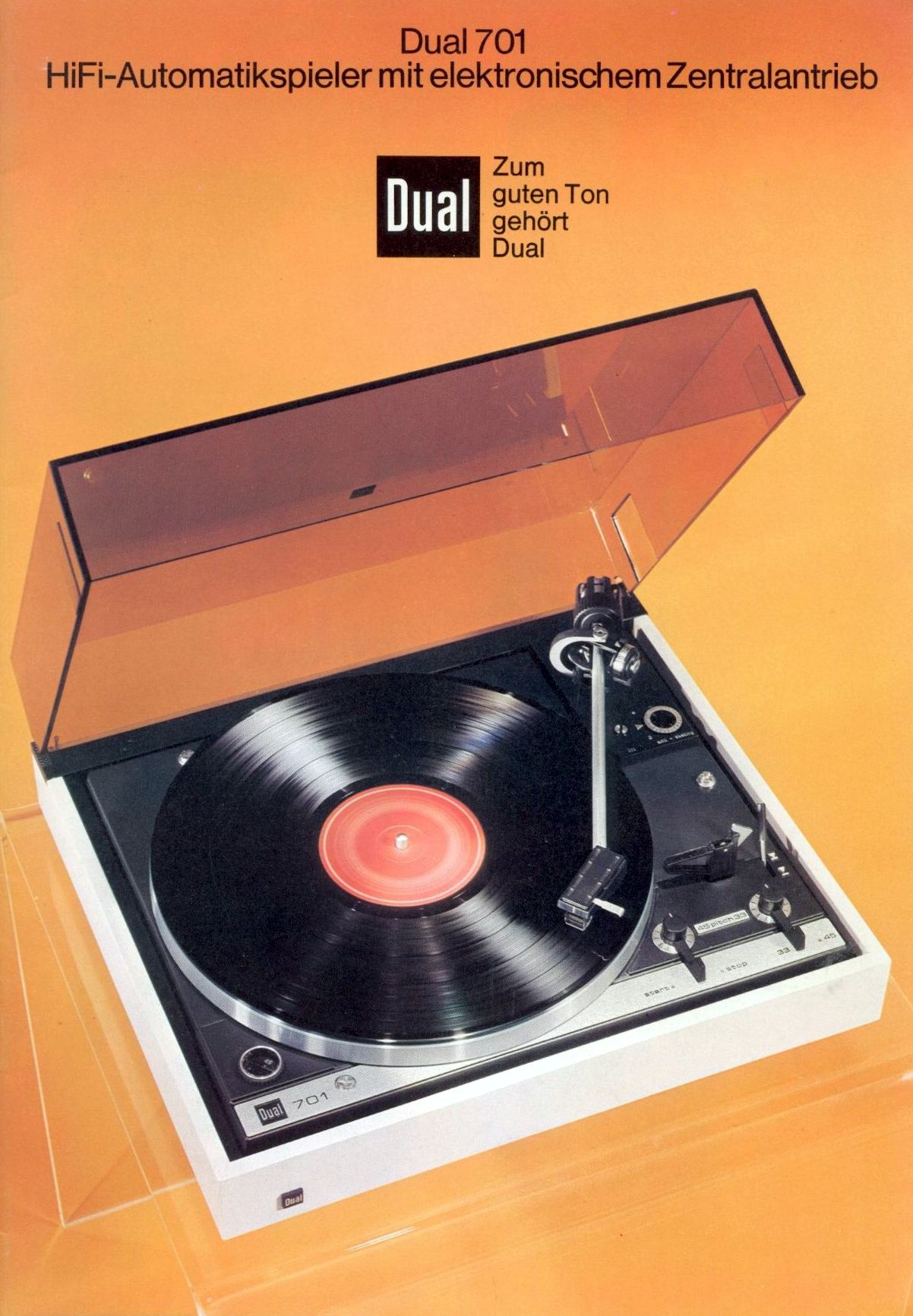Difference between revisions of "Dual CS 701"
| (5 intermediate revisions by the same user not shown) | |||
| Line 1: | Line 1: | ||
__NOTOC__ | __NOTOC__ | ||
| − | == | + | == Data == |
| − | {{ | + | {{navigation}} |
| − | ''' | + | '''General''' |
| − | * | + | * Manufacturer: [[Dual]] |
| − | * | + | * Model: CS 701 |
| − | * | + | * Type: Record player |
| − | * | + | * Years of manufacture: 1973 - 1976 |
| − | * | + | * Made in: Germany |
| − | * | + | * Color: walnut, sanding varnish white |
| − | * | + | * Power consumption: 2,5 Watt |
| − | * | + | * Dimensions: 420 x 147 x 365 mm (WxHxD) |
| − | * | + | * Weight: 10.9 kg |
| − | * | + | * Original price approx.: 900 DM |
| − | ''' | + | '''Connections''' |
| − | * | + | * Outputs: 1 (5-pin DIN plug) |
| − | ''' | + | '''Technical data''' |
| − | * | + | * Drive: Direct (EDS-1000) |
| − | * | + | * Speed: 33 1/3 and 45 rpm |
| − | * | + | * Synchronous speed fluctuations: ± 0.03 % |
| − | * | + | * Rumple-noise-interval: > 50 dB |
| − | * | + | * Rumple-to-noise ratio: > 70 dB |
| − | * | + | * Turntable: |
| − | * Pitch: & | + | ** Diameter: 305 mm |
| + | ** Weight: 2,9 kg | ||
| + | ** Moment of inertia: 460 kp / cm2 | ||
| + | * Operating mode: Fully automatic | ||
| + | * Pitch: ± 8 | ||
| + | * Tonearm : torsionally stiff, extra-long tubular aluminium tonearm in super-flat cardanic four-point pivot mounting | ||
| + | ** Tonearm balance weight with double effective vibration damping (2 x anti-resonator) | ||
| + | ** Effective tonearm length: 222 mm | ||
| + | ** Offset angle: 25° 20' | ||
| + | ** Tangential tracking error angle : 0.16°/cm | ||
| + | ** Tonearm bearing friction (relative to the scanning tip) | ||
| + | *** Vertical: < 0.007 p | ||
| + | Horizontal: < 0.015 p | ||
| + | ** Tracking force continuously adjustable from 0 to 3 p with 1/10 p calibration in the range of 0-1.5 p operationally reliable from 0.25 p tracking force | ||
| + | ** Pick-up head (system carrier) removable, suitable for all pick-up systems with 1/2" mounting and a weight of 2 to 10g (incl. mounting material) | ||
| + | ** Adjustable overhang : 5 mm pick-up system | ||
| − | ''' | + | '''Special Features''' |
| + | * Pickup system: Shure V15 Type III (compared to CS 70 Ortofon M20E) | ||
| + | * Hood can be moved to any position (CS 70 only "close", "open" or completely "take off"). Otherwise there are no differences | ||
| − | |||
| − | |||
| − | == | + | == Remarks == |
| + | * The Dual 701 is the first Dual HiFi turntable with direct drive. The unit is generally considered to be rather prone to failure, with many of the units exhibiting malfunctions ranging from greatly increased speed to total failure. * This could be due to the complicated electronics that were used here for the first time. | ||
| + | * Specimens that still work today will probably continue to do so for a long time, as higher quality capacitors were installed after a certain point. So a working specimen is not to be discouraged. | ||
| + | Worth mentioning are the especially heavy platter, which guarantees an excellent synchronisation, the artistic tone arm and the two high-quality pick-up systems, whereby the Shure V15 III positively stands out. | ||
| + | * Furthermore, the unit has a stroboscope lamp, which reflects the stroboscope strips applied to the underside of the turntable into a small round window. Through an obliquely ground lens in front of it, it is possible to "zoom" from the stripes for 45 revolutions/minute to those for 33 revolutions/minute. | ||
| + | * Both speeds can be fine-tuned individually with separate controls. This is not a mechanical fine adjustment as in earlier models, but an electronic one with potentiometers. | ||
| + | * As a counterweight, a "double" weight is installed here, a so-called anti-resonator, which is supposed to compensate for the smallest vibrations of the tone arm. | ||
| + | * The unit is completely noiseless in operation due to the direct drive, all other technical values are also excellent. Further optimisation of these values is not necessary from a rational point of view. | ||
| + | * The turntable starts up a little slowly despite the direct drive, but this is not surprising given the weight of the drive unit of 4.2 kg. | ||
| + | * If you want a Dual with direct drive, but don't want to miss out on the good build quality of the earlier models, you should go for the 701. The successor models with the initial number 7 are characterized by the same or even better technical features, but leave some wishes open in the haptic area. Almost all parts of the 701 are made of metal. It is available in black, white and imitation wood as well as in a real wood frame (walnut). | ||
| − | |||
| − | |||
| − | + | Other models of the same series: | |
| + | * [[Dual CS 1214]] | ||
| + | * [[Dual CS 1216]] | ||
| + | * [[Dual CS 1218]] | ||
| + | * [[Dual CS 1229]] | ||
| + | * [[Dual CS 701]] | ||
| + | |||
| + | |||
| + | == Pictures == | ||
| + | * Image: Dual CS 701 | ||
| + | [[File:Dual 701.jpg]] | ||
| + | |||
| + | |||
| + | * Picture: Dual CS 701 tonearm | ||
| + | [[File:Dual 701 Tonarm.jpg]] | ||
| + | |||
| + | |||
| + | * Excerpt from brochure: Dual CS 701 | ||
| + | [[File:Dual CS-701-Prospekt-1.jpg]] | ||
| + | |||
| − | |||
| − | |||
| − | |||
== Links == | == Links == | ||
| − | [[ | + | |
| + | [[Category:Turntables]] | ||
Latest revision as of 02:48, 11 December 2018
Data[edit]
General
- Manufacturer: Dual
- Model: CS 701
- Type: Record player
- Years of manufacture: 1973 - 1976
- Made in: Germany
- Color: walnut, sanding varnish white
- Power consumption: 2,5 Watt
- Dimensions: 420 x 147 x 365 mm (WxHxD)
- Weight: 10.9 kg
- Original price approx.: 900 DM
Connections
- Outputs: 1 (5-pin DIN plug)
Technical data
- Drive: Direct (EDS-1000)
- Speed: 33 1/3 and 45 rpm
- Synchronous speed fluctuations: ± 0.03 %
- Rumple-noise-interval: > 50 dB
- Rumple-to-noise ratio: > 70 dB
- Turntable:
- Diameter: 305 mm
- Weight: 2,9 kg
- Moment of inertia: 460 kp / cm2
- Operating mode: Fully automatic
- Pitch: ± 8
- Tonearm : torsionally stiff, extra-long tubular aluminium tonearm in super-flat cardanic four-point pivot mounting
- Tonearm balance weight with double effective vibration damping (2 x anti-resonator)
- Effective tonearm length: 222 mm
- Offset angle: 25° 20'
- Tangential tracking error angle : 0.16°/cm
- Tonearm bearing friction (relative to the scanning tip)
- Vertical: < 0.007 p
Horizontal: < 0.015 p
- Tracking force continuously adjustable from 0 to 3 p with 1/10 p calibration in the range of 0-1.5 p operationally reliable from 0.25 p tracking force
- Pick-up head (system carrier) removable, suitable for all pick-up systems with 1/2" mounting and a weight of 2 to 10g (incl. mounting material)
- Adjustable overhang : 5 mm pick-up system
Special Features
- Pickup system: Shure V15 Type III (compared to CS 70 Ortofon M20E)
- Hood can be moved to any position (CS 70 only "close", "open" or completely "take off"). Otherwise there are no differences
Remarks[edit]
- The Dual 701 is the first Dual HiFi turntable with direct drive. The unit is generally considered to be rather prone to failure, with many of the units exhibiting malfunctions ranging from greatly increased speed to total failure. * This could be due to the complicated electronics that were used here for the first time.
- Specimens that still work today will probably continue to do so for a long time, as higher quality capacitors were installed after a certain point. So a working specimen is not to be discouraged.
Worth mentioning are the especially heavy platter, which guarantees an excellent synchronisation, the artistic tone arm and the two high-quality pick-up systems, whereby the Shure V15 III positively stands out.
- Furthermore, the unit has a stroboscope lamp, which reflects the stroboscope strips applied to the underside of the turntable into a small round window. Through an obliquely ground lens in front of it, it is possible to "zoom" from the stripes for 45 revolutions/minute to those for 33 revolutions/minute.
- Both speeds can be fine-tuned individually with separate controls. This is not a mechanical fine adjustment as in earlier models, but an electronic one with potentiometers.
- As a counterweight, a "double" weight is installed here, a so-called anti-resonator, which is supposed to compensate for the smallest vibrations of the tone arm.
- The unit is completely noiseless in operation due to the direct drive, all other technical values are also excellent. Further optimisation of these values is not necessary from a rational point of view.
- The turntable starts up a little slowly despite the direct drive, but this is not surprising given the weight of the drive unit of 4.2 kg.
- If you want a Dual with direct drive, but don't want to miss out on the good build quality of the earlier models, you should go for the 701. The successor models with the initial number 7 are characterized by the same or even better technical features, but leave some wishes open in the haptic area. Almost all parts of the 701 are made of metal. It is available in black, white and imitation wood as well as in a real wood frame (walnut).
Other models of the same series:
Pictures[edit]
- Image: Dual CS 701
- Picture: Dual CS 701 tonearm
- Excerpt from brochure: Dual CS 701


